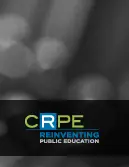This paper analyzes big-city high schools: how they function and how the education of the low-income minority youth in these high schools can be improved. It compares comprehensive (or zoned) high schools, special public magnet schools, and Catholic high schools and identifies school features that motivate low-income children to learn and develop into mature adults. Finally, it suggests how these features can be made more broadly available to urban public high school students.
The study was conducted in New York City, and though most of its findings apply directly to the improvement of that city’s schools, the results also pertain to high school improvement efforts in any major city.





